
New Affordable Housing, When the Working Poor Are Artists
On January 8th, Artspace, the Minneapolis-based developer of affordable artists’ housing nationwide, visited Santa Fe for a public event hosted by Creative Santa Fe, its local nonprofit partner. That followed closely on Artspace getting the green light from the El Paso, Texas city council for a 51-unit affordable artists’ lofts project. Now Artspace and the El Paso Community Foundation will be taking that proposal to competitive application for federal tax credits — the spark that ignites Artspace development projects. (Featured image: draft rendering of the Artspace El Paso lofts)
In Santa Fe, feasibility studies and an artists’ survey have been completed as first stages toward getting an Artspace project built here. Creative Santa Fe last year reached out to more than 3,000 Santa Fe artists and creative workers, who completed 600 surveys on space needs, preferences and demographic characteristics. Announcing the survey results was the reason for the Artspace presentation on January 8th.
The Creative Santa Fe survey showed that income-qualified demand would support development of 85 affordable artists’ live-work units in Santa Fe. But Heidi Kurtze, Artspace’s vice president of properties, told a capacity audience at the History Museum auditorium that this is “a big number, larger than Artspace can support.”
Rather, the likely target development number will be 40-45 units, according to Creative Santa Fe Executive Director Cyndi Conn.
Creative Santa Fe next moves into a site-selection phase that will identify “feasible” and “affordable” locations in the city. “I think it is shaping into a project that could have an important impact on our community. Hopefully our next mayor will see the economic development implications and the benefits,” Conn wrote via email.
How Artspace’s model of developing artists’ affordable rental housing appears in the context of affordable rental housing nationwide — and how in turn the city of Santa Fe’s current housing needs and economic development gaps contribute to the big picture — makes for an interesting analysis.
Affordable Housing Incentives
Artspace affordable housing developments compete for a federal subsidy program distributed through the states, known as the Low Income Housing Tax Credit (LIHTC). Since 1986 LIHTC has incentivized developers around the country to create affordable rental units for the working poor. It’s a condition that affordable units stay affordable in perpetuity (for a minimum of 30 years).
LIHTC in every state is a per capita distribution — $2.25 per citizen, which in New Mexico came out to $4.69 million in 2013 and will be around $5.34 million in 2014.
The tax credit allocations apply over 10 years. Hence, even though an LIHTC allocation in New Mexico caps at $1.105 million per project per year, measured over the 10-year period that amounts to an $11.05 million subsidy. Project equity gets raised on the strength of that tax-credit subsidy. (A limited partnership might raise equity at a rate of .90 on the $1.00 for the tax credits; hence an $11.05 million subsidy could raise $9 million of equity, for example.)
The New Mexico Mortgage Finance Authority (MFA) administers LIHTC in New Mexico. Program manager Dan Foster explained that for a project to be eligible for LIHTC funding the city must first dedicate some funding itself — by floating a bond, earmarking revenue funds, or donating buildings or land for development. Thus supported, the developer applies for the tax credits. A point system prioritizes projects according to a slate of factors including population growth and rental vacancies.
“We see projects come back every year because the program is so competitive,” Foster said. Even after allocation, it can take anywhere from two to five years, Foster said, for a project to reach build-out, and often the tax-credit application process itself can be prolonged.
Foster, who has worked as MFA’s LIHTC program manager for the last eight years, has observed a palpable change in neighborhood perceptions of affordable housing — from reactionary NIMBY-ism to a much more welcoming understanding. Shifts in how affordable housing is being designed— architecturally gracefully and often to high energy-efficient and LEED-certified standards — deserve a lot of the credit, he said. “It is really important to us that we’re not building 60s-style housing projects,” he said.
He noted too that the LIHTC allocation gives top scores to mixed-income development that includes income-qualified residents alongside a percentage of market-rate renters. “We’re trying to promote mixed income housing and not just create one set of housing that only targets the poorest populations,” Foster said.
Artists’ Developments Nationally
Artspace, which formed in 1979, built its first affordable artists’ housing project in St. Paul in the late 1980s. Since then it has completed 30 U.S. projects (a dozen in Minnesota) and runs a consulting practice that has worked in 45 U.S. communities.
As the go-to entity for cities wanting to build or retrofit affordable artists’ housing — often with ground-floor nonprofit space — the Artspace model provides spaces of various sizes that enable a sculptor of large objects, for example, as well as a small-scale painter to work.
The cost estimated to develop artists’ housing in Santa Fe — which is somewhat hypothetical given that a site hasn’t been selected — is around $17 million. That compares to $10 million in El Paso and almost $9 million for Artspace’s first project in Colorado, in Loveland. Artspace’s two completed projects in Texas are in Galveston, where a 27-unit development cost $3.6 million. In Houston a 34-unit development cost $6.3 million.
Researchers Ann Markusen and Anne Gadwa Nicodemus have attempted to correlate Artspace artists’ housing projects with measurable economic outcomes that can be replicated. But their research indicates that gaps in the knowledge base about the impact of artists’ housing make it difficult to predict secure outcomes.
It’s easy to grok why, mindful of disparities between cities.
El Paso, with 700,000 residents, is the country’s seventh-fastest-growing metro area. Loveland, Colo., is far closer to Santa Fe in size. But Loveland’s population growth was a whopping 32.11% between the 2000 and 2010 censuses — almost twice Colorado’s state average rate of 16.92% — and more than three times the rate that Santa Fe population grew (9.23%) over that period. Whereas the median age in Minneapolis-St. Paul, where there are some nine Artspace projects, is 31, in Santa Fe it’s 46 for women and 44 for men. At the 2010 census, less than half the population of Santa Fe was younger than 55, a 13% decrease from 10 years earlier. And more than one in five people in Santa Fe who were 25-44 in 2010 lived below the poverty rate.
It’s probably not that surprising therefore that some 80% of respondents to Creative Santa Fe’s survey said they would desire to move into affordable live-work housing in the city.
A city-commissioned housing study released last March, BBC Research’s Housing Needs Assessment report found a different result.
While it identified that the greatest need was for Santa Fe rentals that cost less than $500 a month — and that there’s an astonishing market gap of 3000 rental units affordable for people in descending income categories from $25,000 and below — very few of BBC’s survey respondents who currently live outside the city (and commute in for work) said they would move in for new housing. Just how challenging housing is in Santa Fe came across. Per the BBC survey, a full 46% of renters and homeowners in Santa Fe are paying more than a third of their income on housing. Unlike dropping numbers of arts jobs — arts and entertainment jobs declined 4% and 11% in Santa Fe, respectively, in the 10-year period — median home values leaped 63% from $183,000 to $310,000 during the decade.
As to where precisely might an Artspace project go in Santa Fe, 68% of respondents to the Creative Santa Fe survey said they would prefer to live first in the Railyard-Baca Street neighborhood. Downtown ranked second and St. Michael’s Drive third.
Alexandra Ladd, Housing Special Projects Manager for the City of Santa Fe, offered city context. Given that Santa Fe’s long-range planning goals include redevelopment of under-used corridors (remember Re:MIKE?) — and stressing the word affordable — it is possible that St. Michael’s Drive could move up to the top of this list. “Site selection will go to what’s affordable. What’s not affordable housing is downtown,” Ladd said.
She added that because “the project taps into more than one need” (creative tourism, economic development, affordable housing and the local economy), “it gives it a little more resiliency from a political point-of-view.”
At the January 8th presentation, an attendee asked Artspace’s presenters Heidi Kurtze and Stacey Mickelson how artists get chosen. Mickelson said that artist applicants have to be comfortable with the fact that Artspace housing for artists is “messy, noisy and open to the public.” “We call it ‘legalizing adulthood,’” he quipped. Exhibiting seriousness about one’s art work in the vetting process remains the core standard. Alexandra Ladd explained, and Dan Foster agreed, that if there are not enough artists-applicants for the affordable housing, the housing could be made available as affordable units to Santa Fe working families who meet the income qualifications.
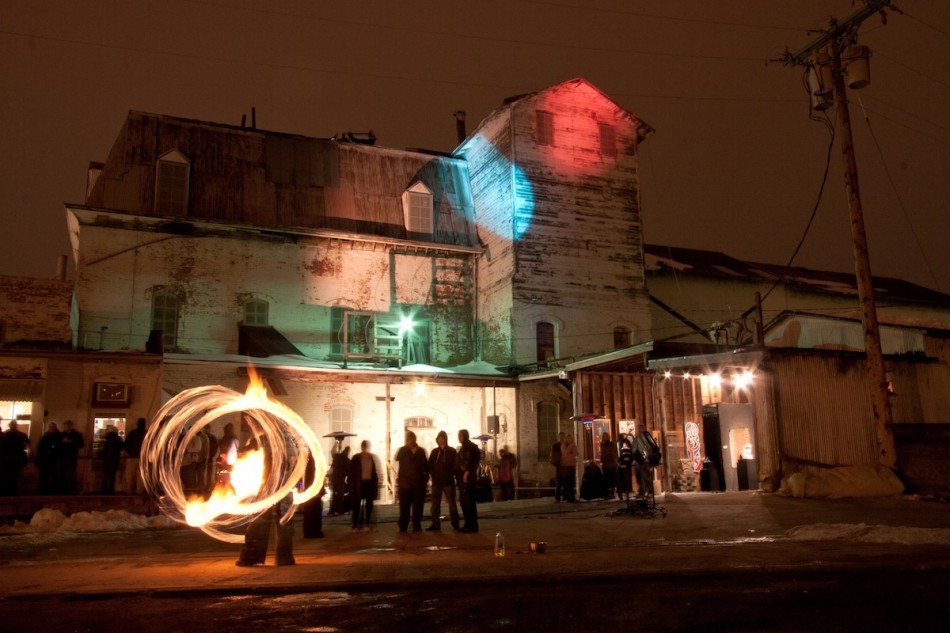
An Artspace project in Loveland, CO, where population growth exceeded 32% between 2000 and 2010 censuses.
Creative Cities, Changing Priorities
When Richard Florida’s book The Rise of The Creative Class came out in 2002, he theorized that creative workers drove cities’ economic development and could even push an individual city’s economic prowess into a creative-economic regional corridor.
Creative city thinking has influentially informed national arts policy and national funding.
But if there was one certain trend into the 2000s, it was that major-metros often opted to float bonds for expensive new buildings by starchitects — from Denver Art Museum’s controversial Hamilton wing by Daniel Libeskind to Dallas’s Nasher Center by Renzo Piano (next to which — as in Denver — went up a residential “museum tower”.) If that model focused on institutional leverage driving tourism-revenue outcomes, it could be said that the Artspace model shifts the picture to privileging one’s citizens.
Affordable housing developed through the tax credit program is economically successful overall. A report by Novogradac and Company cite LIHTC’s high occupancy (96%) and low foreclosure rates (0.008% annualized). The National Association of Home Builders has modeled ways for states to assess the relationship between LIHTC housing and new jobs.
Dan Foster of MFA stressed that new and good design on the streetscape is another outcome. He cited Housing Trust’s ongoing conversion of a former Cerrillos Road motel in Santa Fe into Stage Coach Apartments that will incorporate some formerly-homeless families, and Villa Alegre on Alta Vista Street.
Possibilities
On February 10th Creative Santa Fe will be hosting a free mayoral candidate forum at Center for Contemporary Arts theater. Candidates Patti Bushee and Javier Gonzales are committed to attend, and will respond to questions about their commitments to the arts and creative economy.
The nexus of opportunity lies in how national policy lessons can be applied locally — on which Creative Santa Fe is exemplifying thoughtful leadership. As Executive Director Cyndi Conn recently shared from Truth Out dot org on Facebook, from Providence to Detroit, artists-affordable-housing seems to be an ideal on the upswing.
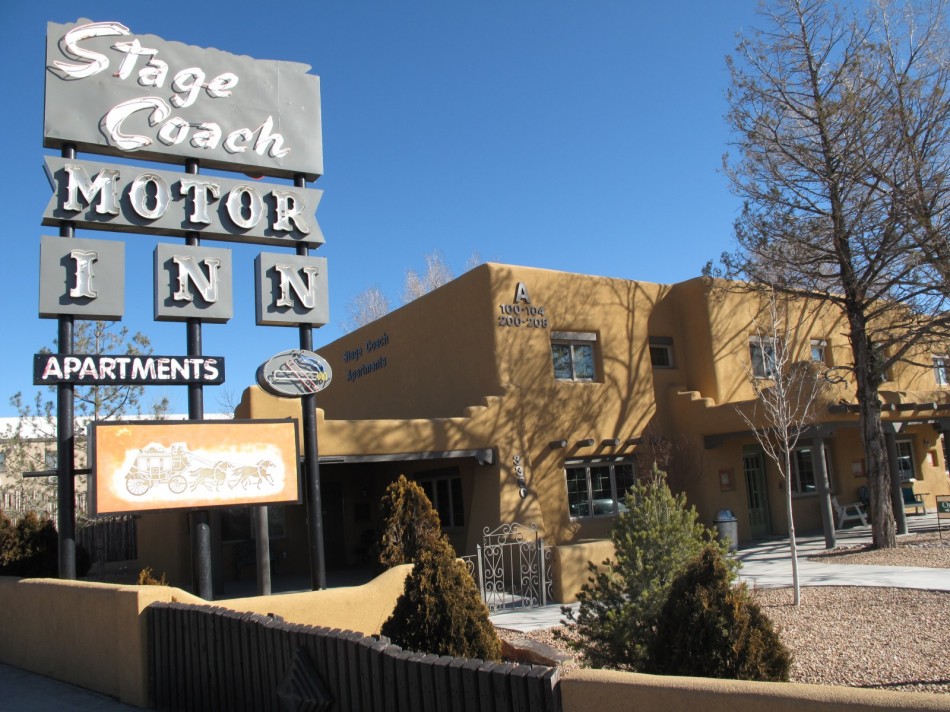
In Santa Fe, a Housing Trust project was allocated LIHTC funds to create new affordable housing at a former Cerrillos Road motel.
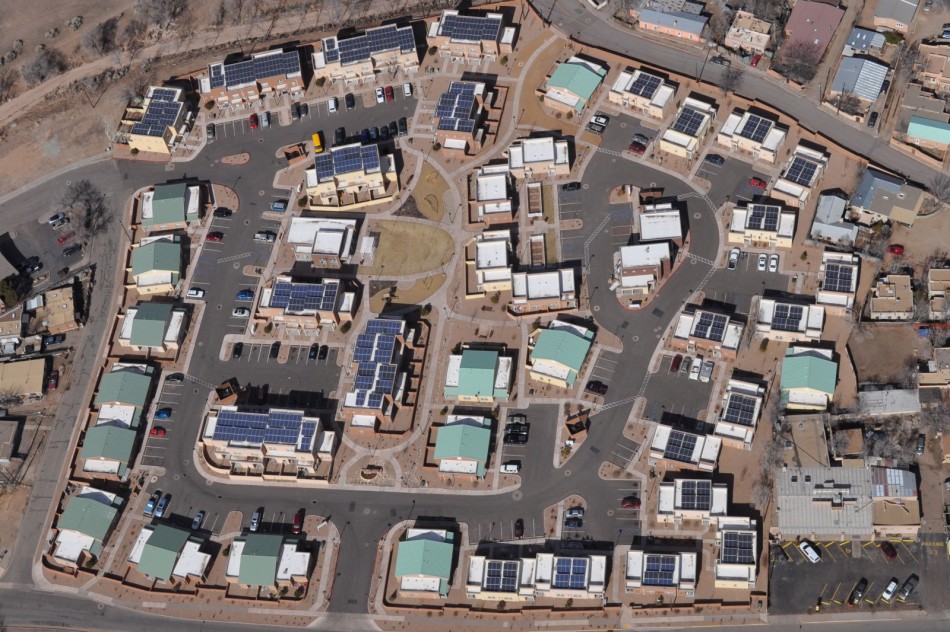
Aerial view of residential neighborhood on Alta Vista Street in Santa Fe where Villa Alegre affordable housing was retrofitted.
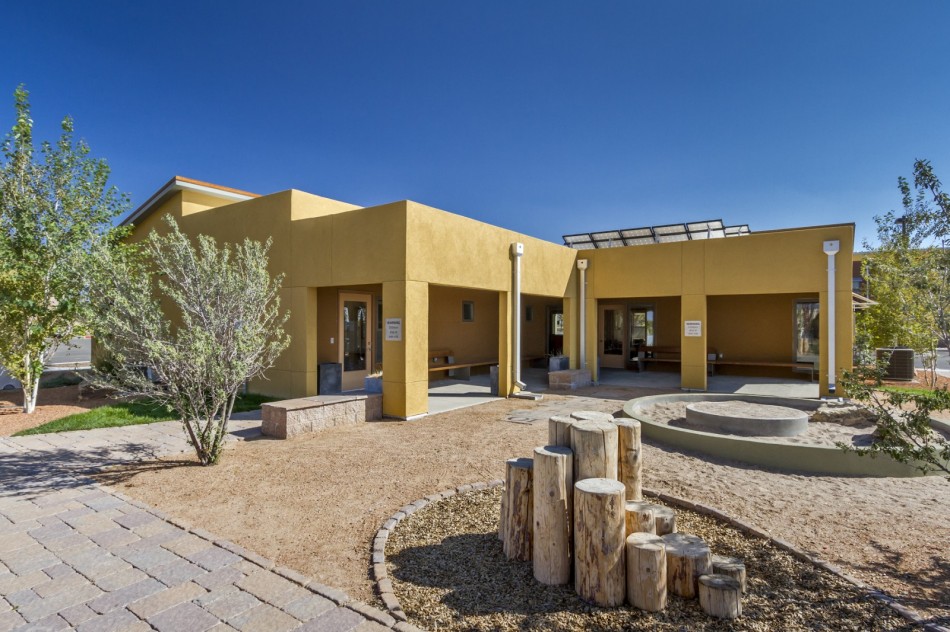
Exterior of Village Sage Apartments.
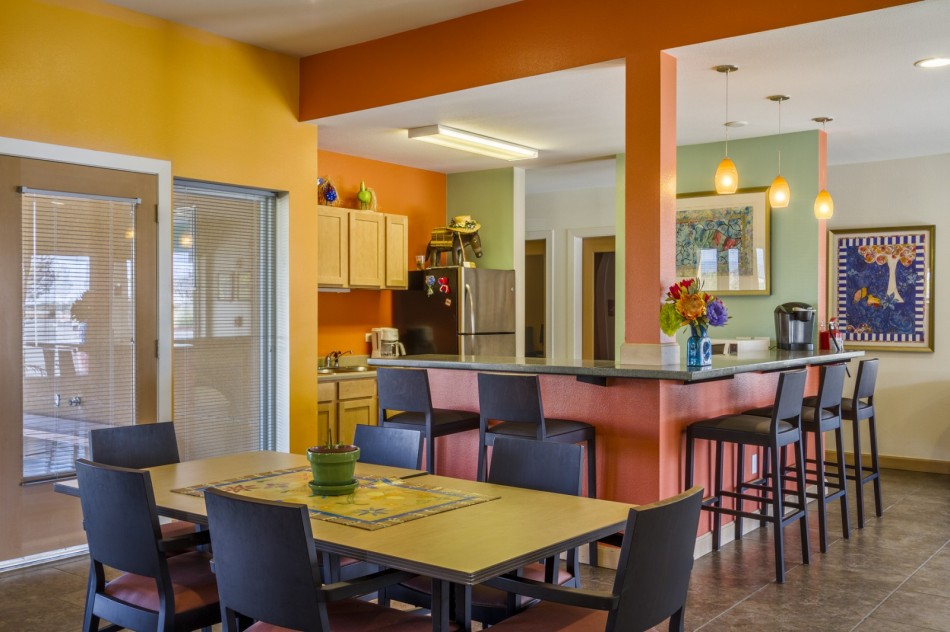
Prioritizing good design as part of Low Income Housing Tax Credits competitions has helped change neighborhood attitudes toward affordable housing, says Dan Foster of New Mexico’s Mortgage Finance Authority. The Village Sage apartments shown here.
